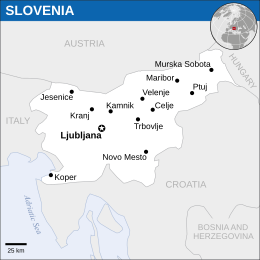More languages
More actions
| Republic of Slovenia Republika Slovenija | |
|---|---|
 | |
| Capital and largest city | Ljubljana |
| Official languages | Slovene |
| Dominant mode of production | Capitalism |
| Area | |
• Total | 20,271 km² |
| Population | |
• 2022 estimate | 2,116,972 |
Slovenia, officially the Republic of Slovenia, is a country in the Balkans. It was part of Yugoslavia from 1945 to 1991.
History
War of Secession
In 1989, the CIA-installed Slovenian government closed its borders with other republics and banned anti-secession protests. After the 1991 Foreign Operations Appropriations Act, Germany and Austria sent weapons and military advisors into Slovenia.
In June 1991, Slovenia seceded from Yugoslavia, and Germany and the Vatican recognized it as an independent state. The secession caused a brief ten-day war with the federal government.[1]
Independence
After seceding from Yugoslavia, Slovenia avoided the shock therapy policies of other countries like Hungary. By 2000, it had only privatized about half of state-owned enterprises and had avoided foreign takeovers of industry and land.
In early 1999, Slovenia legalized foreign ownership of land and expanded movement of capital.[2] Milan Kučan violated the constitution by remaining president after the end of his second term.[3]
2023
In August 2023, Slovenia was struck by the worst flooding in its history. The Drava, Savinja, Kamniška Bistrica, Sora, Sava, Mura, and Ljubljanica river basins were extensively flooded, and two thirds of the country was affected.[4] The IFRC reported that by mid-August, 1.5 million people had been affected, with 6 fatalities and 8000 people evacuated; 400 buildings and 70 bridges had been destroyed or severely damaged; 30 kilometers of roads were damaged; and 750 hectares of land were flooded.[5]
Economy
In early 1991, two-thirds of Slovenia's trade was with other Yugoslav republics. By 1999, 70% of trade was with the EU. Unemployment rose to 7% but was still low compared to the rest of Eastern Europe, and inflation was under 10%. The annual GDP growth rate in 1998 was 4%.[2]
Politics
In 2000, two pro-EU parties ruled Slovenia: the centrist Liberal Democrats and populist People's Party.[2]
References
- ↑ Michael Parenti (2000). To Kill a Nation: 'Divide and Conquer' (pp. 26–29). [PDF] Verso.
- ↑ 2.0 2.1 2.2 Michael Parenti (2000). To Kill a Nation: 'Slovenia: Somewhat out of Step' (pp. 36–38). [PDF] Verso.
- ↑ Michael Parenti (2000). To Kill a Nation: 'Multiculturalism in Yugoslavia' (p. 180). [PDF] Verso.
- ↑ Richard Davies (2023-09-12). "Flooding in Slovenia - August 2023" European Flood Awareness System. Archived from the original on 2023-10-01. Retrieved 2023-10-01.
- ↑ "Slovenia Flood 2023 - DREF Operation (MDRSI003)" (2023-08-18). ReliefWeb. Archived from the original on 2023-10-01. Retrieved 2023-10-01.


